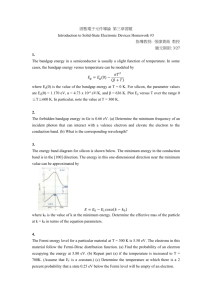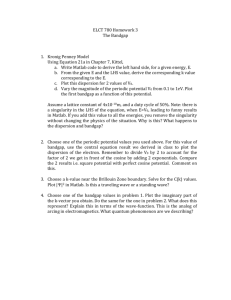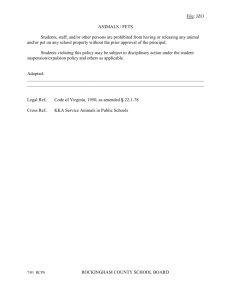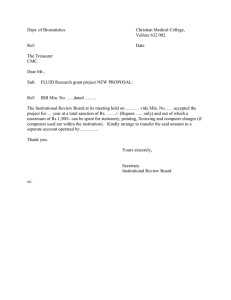MSP430x5xx and MSP430x6xx Family: Reference (REF) Module
advertisement
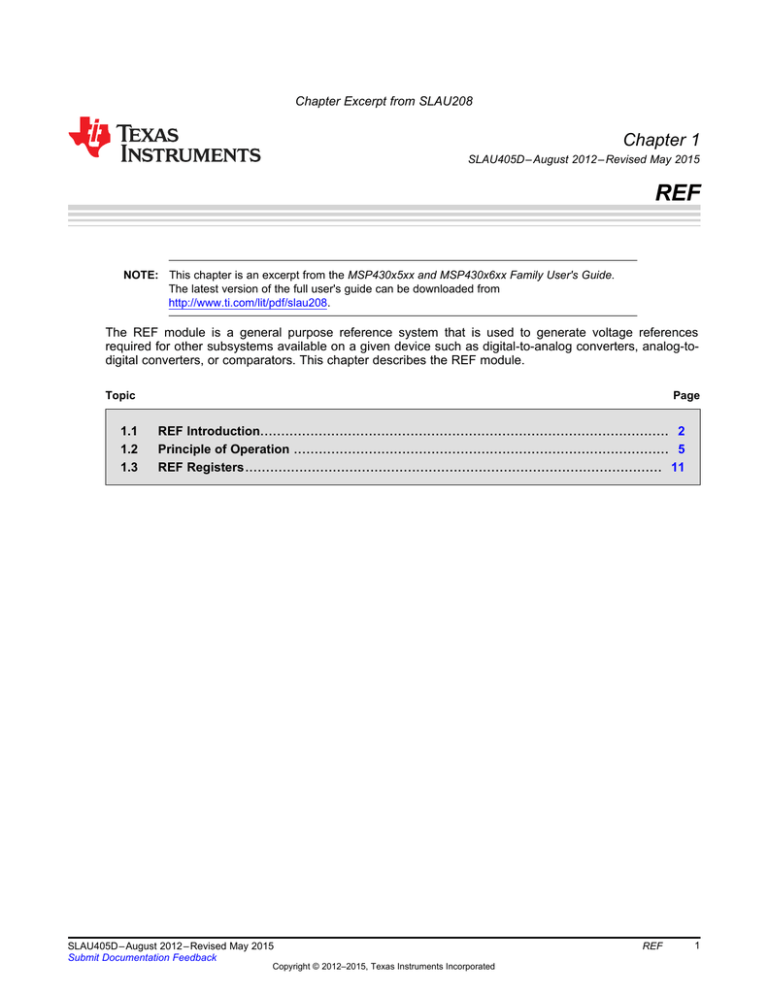
Chapter Excerpt from SLAU208
Chapter 1
SLAU405D – August 2012 – Revised May 2015
REF
NOTE: This chapter is an excerpt from the MSP430x5xx and MSP430x6xx Family User's Guide.
The latest version of the full user's guide can be downloaded from
http://www.ti.com/lit/pdf/slau208.
The REF module is a general purpose reference system that is used to generate voltage references
required for other subsystems available on a given device such as digital-to-analog converters, analog-todigital converters, or comparators. This chapter describes the REF module.
Topic
1.1
1.2
1.3
...........................................................................................................................
Page
REF Introduction.................................................................................................. 2
Principle of Operation .......................................................................................... 5
REF Registers .................................................................................................... 11
SLAU405D – August 2012 – Revised May 2015
Submit Documentation Feedback
Copyright © 2012–2015, Texas Instruments Incorporated
REF
1
Chapter Excerpt from SLAU208
REF Introduction
1.1
www.ti.com
REF Introduction
The reference module (REF) generates all critical reference voltages that can be used by various analog
peripherals in a given device. These include, but are not necessarily limited to, the ADC10_A, ADC12_A,
CTSD16, DAC12_A, LCD_B, and COMP_B modules (availability of a given module depends on the
particular device). The heart of the reference system is the bandgap from which all other references are
derived by unity or noninverting gain stages. The REFGEN subsystem consists of the bandgap, the
bandgap bias, and the noninverting buffer stage, which generates the three primary voltage reference
available in the system, namely 1.5 V, 2.0 V, and 2.5 V. In addition, when enabled, a buffered bandgap
voltage is also available.
Features of the REF include:
• Centralized factory-trimmed bandgap with excellent PSRR, temperature coefficient, and accuracy
• 1.5-V, 2.0-V, or 2.5-V user-selectable internal references
• Buffered bandgap voltage available to rest of system
• Power saving features
• Backward compatibility to existing reference system
Figure 1-1 shows the block diagram of the REF module in an example device with ADC12_A. Figure 1-2
shows the block diagram of the REF module in an example device with a CTSD16 module.
NOTE: For devices with the CTSD16 module, external reference VeREF+ cannot be applied while
internal reference VREFBG is being used by another module, because they share the same
pin,and contention on the signal line will occur. Therefore, if the external reference is used,
make sure that no modules request the internal reference VREFBG.
Devices with ADC10_A might not include the reference voltage output to the external pad. Refer to the
device-specific data sheet.
2
REF
SLAU405D – August 2012 – Revised May 2015
Submit Documentation Feedback
Copyright © 2012–2015, Texas Instruments Incorporated
Chapter Excerpt from SLAU208
REF Introduction
www.ti.com
Bandgap Reference
Variable Reference
REFGEN
+
ADC12_A
+
−
To external pad
−
+
BANDGAP
Vref
−
+
BIAS
Vref/2
To DAC12
Vref/3
To DAC12
To ADC12_A
capacitor array
−
Switch
Mux
1.5/2.0/2.5V
REFGENREQ
From REFGEN
DAC12_A
Channel 0
+
REFBGREQ
−
DAC12OG
REFMODEREQ
From REFGEN
DAC12_A
Channel 1
+
−
DAC12OG
Local
Buffer
Local
Buffer
COMP_B0
COMP_B1
Figure 1-1. REF Block Diagram
SLAU405D – August 2012 – Revised May 2015
Submit Documentation Feedback
Copyright © 2012–2015, Texas Instruments Incorporated
REF
3
Chapter Excerpt from SLAU208
REF Introduction
www.ti.com
VREFBG/VeREF
+
REFGEN
+
COMP_B0
Local
Buffer
Low Power Bandgap Reference
−
REFOUT
+
LCD
Local
Buffer
Bandgap Reference
Request
low power
bandgap
reference
VREFBG
−
OA
AFE biases
BANDGAP
+
Variable Reference
Request
low power
bandgap
reference
request
AFE bias
Vref
CTSD16
−
BIAS
Vref/2
To DAC12
Vref/3
To DAC12
request
VREFBG
reference
and
AFE bias
Switch
Mux
VREFBG/VeREF+
REFGENREQ
1.5/2.0/2.5V
DAC12_A
from REFGEN
Channel 0
Request
from REFGEN
VREFBG Reference
or
variable reference
REFAFEBIASREQ
REFBGGENREQ
REFMODEREQ
REFBGREQ
Channel 1
Figure 1-2. REF Block Diagram for Devices With a CTSD16 Module
4
REF
SLAU405D – August 2012 – Revised May 2015
Submit Documentation Feedback
Copyright © 2012–2015, Texas Instruments Incorporated
Chapter Excerpt from SLAU208
Principle of Operation
www.ti.com
1.2
Principle of Operation
The REF module provides all the necessary voltage references to be used by various peripheral modules
throughout the system. These may include, but are not limited to, devices that contain an ADC10_A,
ADC12_A, CTSD16, DAC12_A, LCD_B, or COMP_B.
The REFGEN subsystem contains a high-performance bandgap. This bandgap has very good accuracy
(factory trimmed), low temperature coefficient, and high PSRR even while operating at low power. The
bandgap voltage is used to generate three voltages through a noninverting amplifier stage, namely 1.5 V,
2.0 V, and 2.5 V. One voltage can be selected at a time. One output of the REFGEN subsystem is the
variable reference line. The variable reference line provides either 1.5 V, 2.0 V, or 2.5 V to the rest of the
system. A second output of the REFGEN subsystem provides a buffered bandgap reference line that can
also be used by modules throughout the system. Devices with a CTSD16 module have a second buffered
bandgap reference line, VREFBG, which is available internally as well as external to the device (refer to the
device-specific data sheet for PxSEL.y bit requirements). Additionally, the REFGEN supports the voltage
references required for the DAC12_A module, when available. Lastly, the REFGEN subsystem also
includes the temperature sensor circuitry, because it is derived from the bandgap. The temperature sensor
is used by an ADC to measure a voltage proportional to temperature.
Table 1-1 describes the difference reference voltages that are available and how to enable them.
Table 1-1. Reference Voltage Generation for Different Devices (1)
REF
Voltage
Low-power
bandgap
Voltage Available
Internal on request from
module
Internal continuously
Internally on request from
module
VREF 1.5 V,
2.0 V, 2.5 V
Internally continuously
Internally and externally
continuously
Internally and externally, on
request from module
How to Enable on
Devices Without CTSD16
How to Enable On
Devices With CTSD16
External Reference Input
to Device (VeREF+) is
Available
Module requests it
Module requests it
Y
REFON = 1
REFON = 1
Y
Module requests it, set
REFVSEL as desired
DAC requests it, set
REFVSEL as desired
Y
REFON = 1, set REFVSEL
as desired
REFON = 1, set REFVSEL
as desired
Y
REFOUT = 1, set
REFVSEL as desired
NA
Not when VREF and
VeREF+ (external
reference input to device)
share a single pin
NA
REFOUT = 1, Set PxSEL.y,
and request from module
VREFBG is always available
inside the device and on
the pin. If PxSEL.y is not
set, VREFBG is not available
inside the chip.
N (2)
NA
REFON = 1, REFOUT = 1,
and set PxSEL.y.
VREFBG is always available
inside the device and on
the pin. If PxSEL.y is not
set, VREFBG is not available
inside the chip.
N (2)
VREFBG
Internally and externally
continuously
(1)
(2)
Refer to the block diagrams in this user's guide for each module to determine which reference voltages are available for each
module.
External reference VeREF+ cannot be applied while internal reference VREFBG is being used by another module, because they share
the same pin, and contention on the signal line will occur. Therefore, if the external reference is selected, make sure that no
other modules are requesting internal reference VREFBG. VeREF+ is available when VREFBG is not enabled.
SLAU405D – August 2012 – Revised May 2015
Submit Documentation Feedback
Copyright © 2012–2015, Texas Instruments Incorporated
REF
5
Chapter Excerpt from SLAU208
Principle of Operation
www.ti.com
1.2.1 Low-Power Operation
The REF module supports low-power applications such as LCD generation. Many of these applications do
not require a very accurate reference, compared to data conversion, yet power is of prime concern. To
support these kinds of applications, the bandgap can be used in a sampled mode. In sampled mode, the
bandgap circuitry is clocked by the VLO at an appropriate duty cycle. This reduces the average power of
the bandgap circuitry significantly, at the cost of accuracy. When not in sampled mode, the bandgap is in
static mode. Its power is at its highest, but so is its accuracy.
Modules automatically can request static mode or sampled mode using their own individual request lines.
In this way, the particular module determines which mode is appropriate for its proper operation and
performance. If any one active module requests static mode, all other modules use static mode, even if
another module requests sampled mode. In other words, static mode always has higher priority than
sampled mode.
1.2.2 REFCTL
The REFCTL registers provide a way to control the reference system from one centralized set of registers.
By default, REFCTL is used as the primary control of the reference system.
1.2.2.1
REFMSTR = 1
This mode is implemented in all devices with ADC10_A and CTSD16. Also all ADC12_A devices except
for MSP430F5438 and MSP430F5438A support this mode.
Setting the reference master bit (REFMSTR = 1), allows the reference system to be controlled through the
REFCTL register. This is the default setting.
Devices with ADC12_A: In this mode (REFMSTR = 1), the legacy control bits inside the ADC register set
(ADC12REFON, ADC12REF2_5V, ADC12TCOFF, and ADC12REFOUT) are do not care. The ADC12SR
and ADC12REFBURST are still controlled through the ADC12_A, because these are very specific to the
ADC12_A module. If REFMSTR is cleared, all settings in the REFCTL are do not care and the reference
system is controlled completely by the legacy control bits inside the ADC12_A module.
Devices with ADC10_A: This is the only mode supported. REFMSTR must be set at all times. ADC10SR
is controlled by the ADC10_A, because these are very specific to the ADC10_A module.
Devices with CTSD16: This is the only mode supported. REFMSTR must be set at all times.
Table 1-2 summarizes the REFCTL bits and their effect on the REF module for all devices except those
with CTSD16 which is summarized Table 1-3
Table 1-2. REF Control of Reference System (REFMSTR = 1) (Default) for Devices Without CTSD16
REF Register
Setting
Function
REFON
Setting this bit enables the REFGEN subsystem, which includes the bandgap, the bandgap bias circuitry, and
the 1.5-V, 2.0-V, or 2.5-V buffer. Setting this bit causes the REFGEN subsystem to remain enabled regardless of
whether or not any module has requested it. Clearing this bit disables the REFGEN subsystem only when there
are no pending requests for REFGEN from any module. REFON must also be set to enable the temperature
sensor when required.
REFVSEL
Selects 1.5 V, 2.0 V, or 2.5 V to be present on the variable reference line when REFON = 1 or REFGEN is
requested by any module.
REFOUT
Setting this bits enables the variable reference line voltage to be present external to the device through a buffer
(external reference buffer).
REFTCOFF
6
REF
Setting this bit disables the temperature sensor (when available) to conserve power.
SLAU405D – August 2012 – Revised May 2015
Submit Documentation Feedback
Copyright © 2012–2015, Texas Instruments Incorporated
Chapter Excerpt from SLAU208
Principle of Operation
www.ti.com
Table 1-3. REF Control of Reference System (REFMSTR = 1) (Default) for Devices With CTSD16
REF Register
Setting
Function
REFON
Setting this bit enables the REFGEN subsystem, which includes the bandgap, the bandgap bias circuitry, AFE
biases, and the 1.5-V, 2.0-V, 2.5-V buffer. Setting this bit causes the REFGEN subsystem to remain enabled
regardless of whether or not any module has requested it. Clearing this bit disables the REFGEN subsystem
only when there are no pending requests for REFGEN from any module. REFON must also be set to enable the
temperature sensor when required.
REFVSEL
Selects 1.5 V, 2.0 V, or 2.5 V to be present on the variable reference line when REFON = 1.
REFOUT
Setting this bits enables the VREFBG voltage to be present internally and external to the device through a buffer
when REFON = 1 or a module requests VREFBG.
REFTCOFF
1.2.2.2
Setting this bit disables the temperature sensor (when available) to conserve power.
REFMSTR = 0
Devices with ADC10_A: Do not support this mode. REFMSTR bit must not be cleared.
Devices with CTSD16: Do not support this mode. REFMSTR bit must not be cleared.
Devices with ADC12_A: This setting is applicable. On legacy devices, the ADC12_A provided the control
bits necessary to configure the reference system, namely ADC12REFON, ADC12REF2_5V,
ADC12TCOFF, ADC12REFOUT, ADC12SR, and ADC12REFBURST. The ADC12SR and
ADC12REFBURST bits are very specific to the ADC12 operation and, therefore, are not included in
REFCTL. All legacy control bits can still be used to configure the reference system, wich allows for
backward compatibility by clearing REFMSTR. In this case, the REFCTL register bits are don't care.
Table 1-4 summarizes the ADC12_A control bits and their effect on the REF module. See the ADC12_A
module description for further details.
NOTE: Although the REF module supports using the ADC12_A bits as control for the reference
system, it is recommended that the use of the new REFCTL register be used and older code
migrated to this methodology. This allows the logical partitioning of the reference system to
be separate from the ADC12_A system and forms a more natural partitioning for future
products.
Table 1-4. Control of Reference System (REFMSTR = 0, ADC12_A Only)
ADC12_A
Register
Setting
Function
ADC12REFON
Setting this bit enables the REFGEN subsystem which includes the bandgap, the bandgap bias circuitry, and the
1.5-V, 2.0-V, 2.5-V buffer. Setting this bit causes the REFGEN subsystem to remain enabled regardless if any
module has requested it. Clearing this bit disables the REFGEN subsystem only when there are no pending
requests for REFGEN from all modules.
ADC12REF2_5
V
Setting this bits causes 2.5 V to be present on the variable reference line when ADC12REFON = 1. Clearing this
bit causes 1.5 V to be present on the variable reference line when ADC12REFON = 1.
ADC12REFOUT
Setting this bits enables the variable reference line voltage to be present external to the device through a buffer
(external reference buffer).
ADC12TCOFF
Setting this bit disables the temperature sensor to conserve power.
As stated previously, the ADC12REFBURST has an effect on the reference system and can be controlled
through the ADC12_A. This bit is in effect regardless of whether REFCTL or the ADC12_A is controlling
the reference system. Setting ADC12REFBURST = 1 enables burst mode when REFON = 1 and
REFMSTR = 1 or when ADC12REFON = 1 and REFMSTR = 0. In burst mode, the internal buffer
(ADC12REFOUT = 0) or the external buffer (ADC12REFOUT = 1) is enabled only during a conversion
and is disabled automatically to conserve power.
SLAU405D – August 2012 – Revised May 2015
Submit Documentation Feedback
Copyright © 2012–2015, Texas Instruments Incorporated
REF
7
Chapter Excerpt from SLAU208
Principle of Operation
www.ti.com
NOTE: The legacy ADC12_A bit ADC12REF2_5V only allows for selecting either 1.5 V or 2.5 V. To
select 2.0 V, the REFVSEL control bits must be used (REFMSTR = 1).
1.2.3 Reference System Requests
There are three basic reference system requests that are used by the reference system. Each module can
use these requests to obtain the proper response from the reference system. The three basic requests are
REFGENREQ, REFBGREQ, and REFMODEREQ. No interaction is required by the user code. The
modules select the proper requests automatically.
A reference request signal, REFGENREQ, is available as an input into the REFGEN subsystem. This
signal represents a logical OR of individual requests coming from the various modules in the system that
require a voltage reference to be available on the variable reference line. When a module requires a
voltage reference, it asserts its corresponding REFGENREQ signal. When the REFGENREQ is asserted,
the REFGEN subsystem is enabled. After the specified settling time, the variable reference line voltage is
stable and ready for use. The REFVSEL settings determine which voltage is generated on the variable
reference line.
In addition to the REFGENREQ, a second reference request signal, REFBGREQ is available. The
REFBGREQ signal represents a logical OR of requests coming from the various modules that require the
bandgap reference line. When the REFBGREQ is asserted, the bandgap, along with its bias circuitry and
local buffer, is enabled if it is not already enabled by a prior request.
The REFMODEREQ request signal is available that configures the bandgap and its bias circuitry to
operate in a sampled or static mode of operation. The REFMODEREQ signal basically represents a
logical AND of individual requests coming from the various analog modules. In reality, a REFMODEREQ
occurs only if a module's REFGENREQ or REFBGQ is also asserted, otherwise it is a do not care. When
REFMODEREQ = 1, the bandgap operates in sampled mode. When a module asserts its corresponding
REFMODEREQ signal, it is requesting that the bandgap operate in sampled mode. Because
REMODEREQ is a logical AND of all individual requests, any modules requesting static mode cause the
bandgap to operate in static mode. The BGMODE bit can be used as an indicator of static or sampled
mode of operation.
1.2.3.1
Specifics for Devices With CTSD16
Devices with a CTSD16 module have two additional request signals. The REFBGGENREQ signal
represents a logical OR of individual requests coming from the various modules in the system that require
the bandgap voltage reference VREFBG to be available on the VREFBG/VeREF+ signal line. When a module
requires a bandgap voltage reference VREFBG, it asserts its corresponding REFBGGENREQ signal. When
the REFBGGENREQ is asserted, the REFGEN subsystem required to generate the bandgap voltage is
enabled. This is different from the bandgap reference line, labeled as low power bandgap reference in the
block diagram, which is requested with the REFGENREQ. The second request signal specific to devices
with a CTSD16 module is the REFAFEBIASREQ. This signal represents a logical OR of individual
requests coming from the various modules in the system that require the AFE biases. When a module
requires the AFE biases, it asserts its corresponding REFAFEBIASREQ signal. When the
REFAFEBIASREQ is asserted, the REFGEN subsystem required to generate the AFE biases is enabled.
1.2.3.2
REFBGACT, REFGENACT, REFGENBUSY
Any module that is using the variable reference line causes REFGENACT to be set inside the REFCTL
register. This bit is read only and indicates to the user that the REFGEN is active or off. Similarly, the
REFBGACT is active any time one or more modules is actively utilizing the bandgap reference line and
indicates to the user that the REFBG is active or off.
The REFGENBUSY signal, when asserted, indicates that a module is using the reference and cannot
have any of it settings changed. For example, during an active ADC12_A conversion, the reference
voltage level should not be changed.
8
REF
SLAU405D – August 2012 – Revised May 2015
Submit Documentation Feedback
Copyright © 2012–2015, Texas Instruments Incorporated
Chapter Excerpt from SLAU208
Principle of Operation
www.ti.com
REFGENBUSY is asserted when any of the following are true:
• there is an active ADC12_A conversion (ENC = 1)
• the DAC12_A is actively converting (DAC12AMPx > 1 and DAC12SREFx = 0 or on devices with
CTSD16 if DAC12SREFx = {2,3} and REFOUT = 1 and REFON = 1 (or bandgap is requested) )
• when CTSD16 is actively converting CTSD16SC = 1 and CTSD16REFS = 1
REFGENBUSY when asserted, write protects the REFCTL register. This prevents the reference from
being disabled or its level changed during any active conversion. Note that there is no such protection for
the DAC12_A if the ADC12_A legacy control bits are used for the reference control. If the user changes
the ADC12_A settings and the DAC12_A is using the reference, the DAC12_A conversion is affected.
1.2.3.3
ADC10_A
For devices that contain an ADC10_A module, the ADC10_A module contains only one local buffer. This
buffer is required when using the internal reference voltage and must be enabled and stable prior to a
conversion.
In devices without a reference output buffer REFOUT must be written 0. Refer to the device-specific data
sheet.
In devices with ADC10_A the REFMSTR bit must be set at all times.
In devices with ADC10_A the REFON bit must be set if the internal reference voltage is used.
1.2.3.4
ADC12_A
For devices that contain an ADC12_A module, the ADC12_A module contains two local buffers. The
larger buffer can be used to drive the reference voltage, present on the variable reference line, external to
the device. This buffer has larger power consumption due to a selectable burst mode, as well as, its need
to drive larger DC loads that may be present outside the device. The large buffer is enabled continuously
when REFON = 1, REFOUT = 1, and ADC12REFBURST = 0. When ADC12REFBURST = 1, the buffer is
enabled only during an ADC conversion, shutting down automatically upon completion of a conversion to
save power. In addition, when REFON = 1 and REFOUT = 1, the second smaller buffer is automatically
disabled. In this case, the output of the large buffer is connected to the capacitor array through an internal
analog switch. This ensures the same reference is used throughout the system. If REFON = 1 and
REFOUT = 0, the internal buffer is used for ADC conversion and the large buffer remains disabled. The
small internal buffer can operate in burst mode as well by setting ADC12REFBURST = 1
1.2.3.5
CTSD16
For devices that contain a CTSD16 module, the VREFBG signal is driven external to the device even if it is
only used internally and requires that PxSEL.y bit = 1. If PxSEL.y is not set, VREFBG is not driven even
internal to the chip. The VREFBG signal is enabled continuously when REFON = 1 and REFOUT = 1. The
CTSD16 module only requests VREFBG during active conversions, when CTSD16SC = 1, and bursts the
VREFBG signal unless REFON = 1 and REFOUT = 1. The DAC12_A similarly bursts the request for the
voltage.
1.2.3.6
DAC12_A
Some devices contain a DAC12_A module. The DAC12_A can use the 1.5 V, 2.0 V, or 2.5 V from the
variable reference line, and on devices with a CTSD16 module, the DAC12_A can use the 1.16 V from the
VREFBG reference line for its reference. The DAC12_A can request its reference directly by the settings
within the DAC12_A module itself except the 1.16 V, which also requires REFOUT = 1. Therefore, if the
DAC is enabled and the internal reference is selected, the DAC requests the reference voltage from the
REF module. In addition, as before, setting REFON = 1 (REFMSTR = 1) or ADC12REFON = 1
(REFMSTR = 0) can enable the variable reference line independent of the DAC12_A control bits.
The REFGEN subsystem provides divided versions of the variable reference line for use in the DAC12_A
module. The DAC12_A module requires either /2 or /3 of the variable reference. The selection of these
depends on the control bits inside the DAC12_A module (DAC12IR, DAC12OG) and is handled
automatically by the REF module.
SLAU405D – August 2012 – Revised May 2015
Submit Documentation Feedback
Copyright © 2012–2015, Texas Instruments Incorporated
REF
9
Chapter Excerpt from SLAU208
Principle of Operation
www.ti.com
When the DAC12_A selects AVcc or VeREF+ or VREFBG (if available) as its reference, the DAC12_A has its
own /2 and /3 resistor string available that scales the input reference appropriately based on the DAC12IR
and DAC12OG settings.
1.2.3.7
LCD_B, LCD_C
In devices that contain an LCD module, the LCD module requires a reference to generate the proper LCD
voltages. The bandgap reference line from the REFGEN subsystem is used for this purpose. The LCD is
enabled when LCDON = 1 of the LCD_B or LCD_C module. This causes a REFBGREQ from the LCD
module to be asserted. The buffered bandgap is made available on the bandgap reference line for use
inside the LCD module.
10
REF
SLAU405D – August 2012 – Revised May 2015
Submit Documentation Feedback
Copyright © 2012–2015, Texas Instruments Incorporated
Chapter Excerpt from SLAU208
REF Registers
www.ti.com
1.3
REF Registers
The REF registers are listed in Table 1-5. The base address can be found in the device specific
datasheet. The address offset is listed in Table 1-5.
NOTE: All registers have word or byte register access. For a generic register ANYREG, the suffix
"_L" (ANYREG_L) refers to the lower byte of the register (bits 0 through 7). The suffix "_H"
(ANYREG_H) refers to the upper byte of the register (bits 8 through 15).
Table 1-5. REF Registers
Offset
Acronym
Register Name
Type
Access
Reset
Section
00h
REFCTL0
REF Control Register 0
Read/write
Word
0080h
Section 1.3.1
00h
REFCTL0_L
Read/write
Byte
80h
01h
REFCTL0_H
Read/write
Byte
00h
SLAU405D – August 2012 – Revised May 2015
Submit Documentation Feedback
Copyright © 2012–2015, Texas Instruments Incorporated
REF
11
Chapter Excerpt from SLAU208
REF Registers
www.ti.com
1.3.1 REFCTL0 Register (offset = 00h) [reset = 0080h]
REF Control Register 0
Figure 1-3. REFCTL0 Register
15
14
13
12
r0
r0
r0
r0
5
Reserved
7
6
REFMSTR
Reserved
rw-(1)
r0
4
REFVSEL
rw-(0)
rw-(0)
11
10
9
8
BGMODE
REFGENBUSY
REFBGACT
REFGENACT
r-(0)
r-(0)
r-(0)
r-(0)
3
2
1
0
REFTCOFF
Reserved
REFOUT
REFON
rw-(0)
r0
rw-(0)
rw-(0)
Can be modified only when REFGENBUSY = 0.
Table 1-6. REFCTL0 Register Description
Bit
Field
Type
Reset
Description
15-12
Reserved
R
0h
Reserved. Always reads as 0.
11
BGMODE
R
0h
Bandgap mode. Read only.
0b = Static mode
1b = Sampled mode
10
REFGENBUSY
R
0h
Reference generator busy. Read only.
0b = Reference generator not busy
1b = Reference generator busy
9
REFBGACT
R
0h
Reference bandgap active. Read only.
0b = Reference bandgap buffer not active
1b = Reference bandgap buffer active
8
REFGENACT
R
0h
Reference generator active. Read only.
0b = Reference generator not active
1b = Reference generator active
7
REFMSTR
RW
1h
REF master control. ADC10_A and CTSD16 devices: Must be written 1.
0b = Reference system controlled by legacy control bits inside the ADC12_A
module when available.
1b = Reference system controlled by REFCTL register. Common settings inside
the ADC12_A module (if exists) are don't care.
6
Reserved
R
0h
Reserved. Always reads as 0.
5-4
REFVSEL
RW
0h
Reference voltage level select for devices
00b = 1.5 V available when reference requested
01b = 2.0 V available when reference requested
10b = 2.5 V available when reference requested
11b = 2.5 V available when reference requested
or REFON
or REFON
or REFON
or REFON
=1
=1
=1
=1
3
REFTCOFF
RW
0h
Temperature sensor disabled
0b = Temperature sensor enabled
1b = Temperature sensor disabled to save power
2
Reserved
R
0h
Reserved. Always reads as 0.
1
REFOUT
RW
0h
Reference output buffer. ADC10_A devices without reference output buffer: Must
be written 0.
0b = Reference output not available externally
1b = Reference output available externally. If ADC12REFBURST = 0, or
DAC12_A is enabled, output is available continuously. If ADC12REFBURST = 1,
output is available only during an ADC12_A conversion.
For devices with CTSD16, REFON must also be set to 1 for VREFBG to be
available continuously. Otherwise, VREFBG is only available externally when a
module requests it.
12
REF
SLAU405D – August 2012 – Revised May 2015
Submit Documentation Feedback
Copyright © 2012–2015, Texas Instruments Incorporated
Chapter Excerpt from SLAU208
REF Registers
www.ti.com
Table 1-6. REFCTL0 Register Description (continued)
Bit
Field
Type
Reset
Description
0
REFON
RW
0h
Reference enable.
ADC10_A: The ADC10_A does not support the reference request. REFON must
be set if the internal reference voltage is used.
0b = Disables reference if no other reference requests are pending.
1b = Enables reference.
SLAU405D – August 2012 – Revised May 2015
Submit Documentation Feedback
Copyright © 2012–2015, Texas Instruments Incorporated
REF
13
IMPORTANT NOTICE
Texas Instruments Incorporated and its subsidiaries (TI) reserve the right to make corrections, enhancements, improvements and other
changes to its semiconductor products and services per JESD46, latest issue, and to discontinue any product or service per JESD48, latest
issue. Buyers should obtain the latest relevant information before placing orders and should verify that such information is current and
complete. All semiconductor products (also referred to herein as “components”) are sold subject to TI’s terms and conditions of sale
supplied at the time of order acknowledgment.
TI warrants performance of its components to the specifications applicable at the time of sale, in accordance with the warranty in TI’s terms
and conditions of sale of semiconductor products. Testing and other quality control techniques are used to the extent TI deems necessary
to support this warranty. Except where mandated by applicable law, testing of all parameters of each component is not necessarily
performed.
TI assumes no liability for applications assistance or the design of Buyers’ products. Buyers are responsible for their products and
applications using TI components. To minimize the risks associated with Buyers’ products and applications, Buyers should provide
adequate design and operating safeguards.
TI does not warrant or represent that any license, either express or implied, is granted under any patent right, copyright, mask work right, or
other intellectual property right relating to any combination, machine, or process in which TI components or services are used. Information
published by TI regarding third-party products or services does not constitute a license to use such products or services or a warranty or
endorsement thereof. Use of such information may require a license from a third party under the patents or other intellectual property of the
third party, or a license from TI under the patents or other intellectual property of TI.
Reproduction of significant portions of TI information in TI data books or data sheets is permissible only if reproduction is without alteration
and is accompanied by all associated warranties, conditions, limitations, and notices. TI is not responsible or liable for such altered
documentation. Information of third parties may be subject to additional restrictions.
Resale of TI components or services with statements different from or beyond the parameters stated by TI for that component or service
voids all express and any implied warranties for the associated TI component or service and is an unfair and deceptive business practice.
TI is not responsible or liable for any such statements.
Buyer acknowledges and agrees that it is solely responsible for compliance with all legal, regulatory and safety-related requirements
concerning its products, and any use of TI components in its applications, notwithstanding any applications-related information or support
that may be provided by TI. Buyer represents and agrees that it has all the necessary expertise to create and implement safeguards which
anticipate dangerous consequences of failures, monitor failures and their consequences, lessen the likelihood of failures that might cause
harm and take appropriate remedial actions. Buyer will fully indemnify TI and its representatives against any damages arising out of the use
of any TI components in safety-critical applications.
In some cases, TI components may be promoted specifically to facilitate safety-related applications. With such components, TI’s goal is to
help enable customers to design and create their own end-product solutions that meet applicable functional safety standards and
requirements. Nonetheless, such components are subject to these terms.
No TI components are authorized for use in FDA Class III (or similar life-critical medical equipment) unless authorized officers of the parties
have executed a special agreement specifically governing such use.
Only those TI components which TI has specifically designated as military grade or “enhanced plastic” are designed and intended for use in
military/aerospace applications or environments. Buyer acknowledges and agrees that any military or aerospace use of TI components
which have not been so designated is solely at the Buyer's risk, and that Buyer is solely responsible for compliance with all legal and
regulatory requirements in connection with such use.
TI has specifically designated certain components as meeting ISO/TS16949 requirements, mainly for automotive use. In any case of use of
non-designated products, TI will not be responsible for any failure to meet ISO/TS16949.
Products
Applications
Audio
www.ti.com/audio
Automotive and Transportation
www.ti.com/automotive
Amplifiers
amplifier.ti.com
Communications and Telecom
www.ti.com/communications
Data Converters
dataconverter.ti.com
Computers and Peripherals
www.ti.com/computers
DLP® Products
www.dlp.com
Consumer Electronics
www.ti.com/consumer-apps
DSP
dsp.ti.com
Energy and Lighting
www.ti.com/energy
Clocks and Timers
www.ti.com/clocks
Industrial
www.ti.com/industrial
Interface
interface.ti.com
Medical
www.ti.com/medical
Logic
logic.ti.com
Security
www.ti.com/security
Power Mgmt
power.ti.com
Space, Avionics and Defense
www.ti.com/space-avionics-defense
Microcontrollers
microcontroller.ti.com
Video and Imaging
www.ti.com/video
RFID
www.ti-rfid.com
OMAP Applications Processors
www.ti.com/omap
TI E2E Community
e2e.ti.com
Wireless Connectivity
www.ti.com/wirelessconnectivity
Mailing Address: Texas Instruments, Post Office Box 655303, Dallas, Texas 75265
Copyright © 2015, Texas Instruments Incorporated
